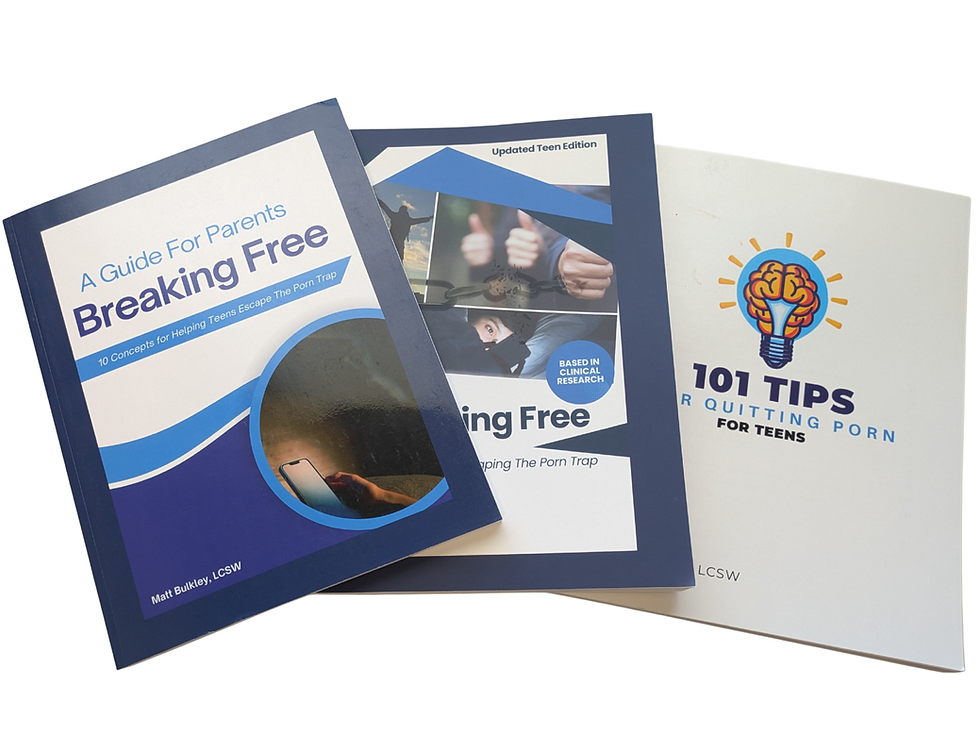Helping Your Teen Overcome Pornography Addiction: Why Avoiding Unrestricted Internet Access Alone Is Key
- Matt Bulkley

- Jun 15
- 4 min read
Updated: Jun 18
As a parent, discovering your teen’s struggle with pornography addiction can feel overwhelming. You want to guide them toward recovery, but it’s hard to know where to start. One critical step is ensuring they avoid being alone with unrestricted internet access. This simple strategy can significantly reduce the risk of relapse and create a safer environment for their recovery. Backed by research and expert insights, here’s why this matters and how you can help your teen navigate it with empathy and practicality.
Why Unrestricted Internet Access Alone Is a Risk
For teens battling pornography addiction, the internet can be a minefield, especially when they’re alone with no safeguards in place. Smartphones, laptops, or tablets without restrictions offer instant access to tempting content, and solitude can amplify the urge to give in. Here’s why this combination is so dangerous and how it impacts your teen’s recovery:
Easy Access Fuels Temptation
A 2021 study in the Journal of Behavioral Addictions found that unrestricted internet access significantly increases the likelihood of returning to pornography, particularly when teens are alone. Without barriers like filters or monitoring, the temptation is just a click away. Therapists working with teens in recovery, as noted in a 2022 Sexual Addiction & Compulsivity report, often hear that solitary moments with unrestricted devices are when cravings hit hardest. Removing easy access creates a vital buffer against relapse.
Boredom Drives Mindless Scrolling
When teens are alone with nothing to do, boredom can lead to aimless internet use, which often spirals into pornography. A 2020 study in Addictive Behaviors highlighted that unrestricted screen time in solitary settings makes it easier for old habits to resurface. Without internet filters or time limits, there’s little to stop a fleeting thought from becoming a full-blown slip-up. Creating boundaries reduces the chance of these vulnerable moments.
The Brain’s Reward Cycle Thrives in Isolation
Pornography addiction is fueled by dopamine, the brain’s reward chemical, which creates a craving for quick gratification. A 2019 study in Cyberpsychology, Behavior, and Social Networking found that unrestricted internet access keeps this dopamine loop active, especially when teens are alone with no one to interrupt their behavior. In solitude, the pull of pornography feels stronger because there’s no external accountability to break the cycle. Counselors often recommend tools like blockers or keeping devices in shared spaces to disrupt this pattern.
Loneliness Amplifies the Urge
Being alone can heighten feelings of disconnection or loneliness, which often drive teens to pornography as a false sense of comfort. A 2021 Psychology of Addictive Behaviors study linked solitary, unrestricted internet use to increased emotional distress, making relapse more likely. Experts emphasize that accountability—whether through family presence or monitoring apps—can counteract this risk by fostering connection and reducing the sense of isolation.
Practical Steps to Create a Safer Environment
Helping your teen avoid being alone with unrestricted internet access doesn’t mean constant surveillance, but rather setting up smart boundaries that support their recovery. Here are practical ways to implement this strategy:
Install Internet Filters and Monitoring Tools: Use software like Covenant Eyes, Net Nanny, or built-in parental controls to block explicit content and monitor usage. These tools create a layer of protection, reducing the chance of accidental or intentional exposure. Discuss the purpose openly with your teen, framing it as a way to support their goals, not as punishment.
Keep Devices in Shared Spaces: Encourage your teen to use phones, laptops, or tablets in common areas like the living room or kitchen, especially during downtime. This reduces the temptation to browse privately and fosters accountability naturally. Consider setting a rule that devices stay out of bedrooms, particularly at night.
Set Time Limits for Internet Use: Use apps or router settings to restrict internet access during certain hours, such as late at night when temptation peaks. This helps curb mindless scrolling and creates structure around screen time.
Encourage Social Activities: Help your teen fill their time with meaningful activities, like sports, hobbies, or spending time with friends and family. Staying engaged reduces the likelihood of solitary moments that lead to boredom or loneliness.
Foster Open Communication: Create a safe space for your teen to talk about their struggles without fear of judgment. Let them know you’re on their side and that these boundaries are meant to help them succeed. Ask how you can support them in moments when they feel tempted.
Supporting Your Teen’s Recovery Journey
Avoiding unrestricted internet access alone is a powerful step, but it’s most effective when paired with holistic support. Consider connecting your teen with a counselor or therapist who specializes in addiction to address underlying issues like stress, anxiety, or low self-esteem. Support groups or online communities can also provide encouragement and accountability, helping your teen feel less alone in their journey.
As a parent, your role is to guide with patience and empathy. Recovery from pornography addiction takes time, and setbacks may happen. By creating an environment with clear boundaries, you’re giving your teen the tools they need to build resilience and make healthier choices.
A Step Toward Freedom
Helping your teen avoid being alone with unrestricted internet access is a practical way to protect them from relapse and support their recovery from pornography addiction. By setting up filters, keeping devices in shared spaces, and fostering connection, you’re reducing temptation, combating boredom, and breaking the cycle of isolation. These small changes can make a big difference in their journey toward healing.
Start today—talk with your teen about setting up internet safeguards, explore monitoring tools, and encourage activities that keep them engaged. With your support, they can take meaningful steps toward a healthier, stronger future.
Resources for Parents
For answers to questions about pornography addiction and recovery, check out our Recovery Tools for Teens.










Comments